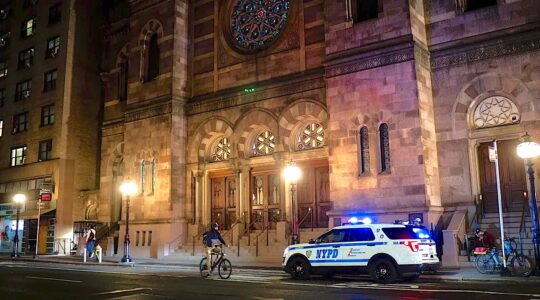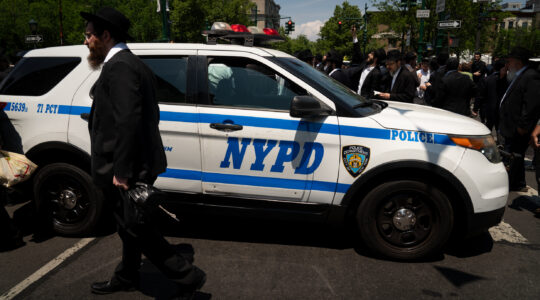I didn’t know who Hank Williams was when I first listened to Leonard Cohen’s “Tower of Song,” with the perplexing lyrics: “I said to Hank Williams, How lonely does it get? … Hank Williams hasn’t answered yet.”
After years of sort of wondering, I found out about Williams when I accidentally passed through Oak Hill, W. Va., where the great country music singer died more than a half-century ago at 29.
Country songs seem a fitting soundtrack for the green forests and rolling hills of southern West Virginia, a place with more than its share of heartbreak and missed opportunities. Country music played on all but a few of the radio stations I picked up driving from Oak Hill to Fayetteville, a lovely resort town in the mountains, and Charleston, the pretty state capital whose historic Jewish community is — like the city itself — at a juncture of sorts.
Tiny Charleston (pop. 50,000) lies at the nexus of three major Interstate highways — about halfway between Cleveland and Charlotte — and if you pick up I-64 in the West Virginia capital, you’re in for a picturesque drive west through the heart of bluegrass America.
Oak Hill feels like a place time forgot; Hank Williams was probably the last celebrity to make history there. But scenic Fayetteville, about an hour south of Charleston, is a picturesque little charmer and a favorite of outdoor enthusiasts. Neither is likely to be a destination for New Yorkers, but if you’re road-tripping through the area, this corner of Appalachia makes a worthwhile stop.
Like Morgantown, West Virginia’s other major city and home to West Virginia University, Charleston is set on a river, but the capital is far prettier and takes better advantage of its waterfront. On summer evenings, wild guitar riffs and blues chords waft from the “Live on the Levee” concert series at Haddad Riverfront Park, where Charlestonians walk their dogs and enjoy sunset views over the Kanawha River.
The New River Gorge. RIVER CREDIT: Wikimedia Commons
Anchored by the revived riverfront and a stately brick historic district, downtown Charleston feels optimistic despite the deep poverty and well-documented social problems of its surrounding region. Before you even leave your car, you notice the lively grassroots arts scene: Mountain Arts Stage is a long-running public radio hit.
2003 saw the opening of the ambitious Clay Center, a performing arts and cultural complex that is home to the West Virginia Symphony and the popular Avampato Discovery Museum. With a planetarium, interactive science exhibits on light, sound, color and magnetism, and a touchable play area for the preschool set, the Avampato makes a great diversion for road-weary children.
A short jog east are two Jewish congregations dating to the 19th century whose families have long roots in Charleston’s shifting fortunes. Congregation B’nai Jacob, a striking brick and stone building, offers traditional daily services; the synagogue, which bills itself as “Traditional Judaism,” lies just down a tree-lined street of Tudor homes from the sprawling green lawns of the capitol complex, which include the gold-domed statehouse and a rather forbidding Soviet-style building that houses the State Museum.
In May, the congregation celebrated the restoration of its historic South Hills cemetery with new retaining walls and benches. And a few blocks west, the Reform Temple Israel maintains the oldest Jewish cemetery in West Virginia — circa 1836. The temple itself was organized two decades later, seven years before the creation of the State of West Virginia, and takes pride in its status as a founding member of the Union for Reform Judaism. But while local ties run deep, Charleston’s Jewish population is in a long decline; the two congregations are currently in talks about consolidating into a united community center, a move that would provide stability but require considerable compromise.
Also in decline is the Appalachian coal industry, which fueled (pun intended) the 19th-century growth of this region. Today, tourism has replaced mining in Fayetteville, which boasts a pretty historic district full of country gift shops and friendly cafés, all in the shadow of cool green hills. It’s certainly worth a stroll for the Revival-style courthouse and grand old hotels that line its well-kept main street.
Support the New York Jewish Week
Our nonprofit newsroom depends on readers like you. Make a donation now to support independent Jewish journalism in New York.
But most visitors come for the outdoor scenery. About a mile out of town is the New River Gorge, where soaring cliffs draw legions of rock climbers and mountain bikers, while kayakers and whitewater rafters ply the river below. Even the non-athletic should make a detour to behold the New River Gorge Bridge, the longest arch bridge in the Western Hemisphere. It’s the visual icon of this area, inspiring countless Instagram posts and even its own annual holiday; a drive over this plunging green canyon, especially if the gorge is shrouded in mist, makes as memorable a souvenir as any.
The New York Jewish Week brings you the stories behind the headlines, keeping you connected to Jewish life in New York. Help sustain the reporting you trust by donating today.




